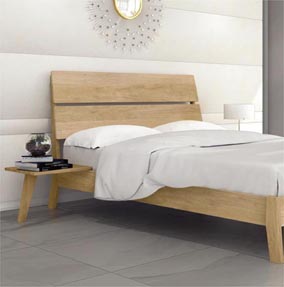Copeland Furniture is Green Furniture
Preservation and stewardship are values that run deep in Vermont. We take pride in the quality of the environment and the natural beauty that surrounds us. Here are some of the ways that our environmental values are reflected in each piece of furniture that we make:
We use sustainably harvested hardwoods from the American Northern Forest
The lumber we use comes from the American Northern Forest, much of it within 500 miles of our factory, consuming less energy in transporting raw material to the factory. An independent research study,* commissioned by the American Hardwood Export Council (AHEC) and conducted by a team of international experts confirms that:
- 1. U.S. hardwoods derive from legal and well managed forests. Hardwood procured from anywhere in the hardwood states could be considered Low Risk in all five Forest Stewardship Council (FSC) controlled wood risk categories.
- 2. There exists, a low risk that U.S. hardwoods are produced from controversial sources as defined in the Chain of Custody standard of the Program for the Endorsement of Forest Certification (PEFC).
- 3. The U.S. hardwood-producing region can be considered low risk for illegal and non-sustainable hardwood sourcing as a result of public and private regulatory and non-regulatory programs.
We were awarded Silver Exemplary Membership Status by Sustainable Furnishings Council.
Copeland Furniture was awarded Silver Exemplary Membership Status by Sustainable Furnishings Council (SFC), joining only a handful of companies to have been awarded this prestigious distinction for proven performance in meeting a range of specific sustainability measures.
Recipient of the Sage Award for environmental excellence
Sponsored by the American Home Furnishings Alliance (AHFA), the award program was launched to recognize environmental accomplishments within the home furnishings industry. For more information go to www.sageaward.org
Standard finish is GREENGUARD Certified.
We use a post-catalyzed conversion varnish that is GREENGUARD Certified for low chemical emissions as the default finish option on all of our products. GREENGUARD certification is a testing program of UL (Underwriters Laboratory) focusing on the issue of indoor air quality. Further information about GREENGUARD certification, can be found at: www.greenguard.org
WE USE CertiPUR-US® CERTIFIED FOAM.
Certified flexible polyurethane foams meet CertiPUR-US® program standards for content, emissions and durability, and are analyzed by independent, accredited testing laboratories.
CertiPUR-US® approved foams are:
We Produce Renewable Energy
With more than 1,000,000 kWh of solar production and 3,500,000 BTUs of bio-mass heat generation capacity, we generate 95% of our own energy, onsite. Based on figures provided by the EPA’s eGRID, our two solar installations offset over 1.5 million pounds of CO2 emissions annually.

We create durable furniture with timeless designs that will last generations.
Heirloomquality furniture has less environmental impact than a piece that will fail or has a “fashion life.” As an example of quality design, our Contour bedroom group won the 2014 ASFD (American Society of Furniture Designers) Pinnable Award for the best new bedroom design. All of our furniture is built using time-tested joinery and construction methods, durable finishes and quality hardware.
We're not done.
While the environmental impact of our factory and the environmental cost of the furniture we build for you is among the lowest, we're not standing still. We've continued to work to reduce VOC (volatile organic compounds) emissions. We've reduced packaging material purchases with the installation of a box making machine that allows us to make only what we need. We recycle all packaging waste and have reduced our reliance on landfill disposal. We now heat our building completely with wood waste from our manufacturing operation further reducing our consumption of imported oil.



